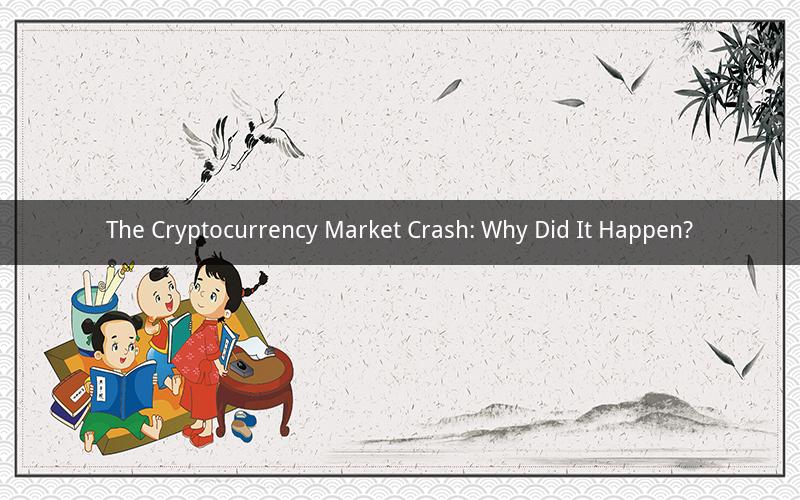
Introduction:
The cryptocurrency market has experienced a series of crashes throughout its short history. One of the most significant crashes occurred in 2022, causing a significant decline in the value of various cryptocurrencies. This article aims to explore the reasons behind the cryptocurrency market crash and shed light on the factors that contributed to its downfall.
1. Market Speculation:
One of the primary reasons for the cryptocurrency market crash was excessive market speculation. Investors, both retail and institutional, were driven by greed and the desire for quick profits. This speculative behavior led to a rapid increase in the prices of cryptocurrencies, creating an artificial bubble. As the bubble burst, investors rushed to sell their holdings, causing a massive sell-off and subsequent crash.
2. Regulatory Concerns:
Regulatory authorities around the world have been closely monitoring the cryptocurrency market. Concerns regarding the lack of regulation and the potential risks associated with cryptocurrencies have contributed to the market crash. Governments and financial institutions have expressed concerns about money laundering, terrorism financing, and market manipulation. These concerns have led to increased scrutiny and regulatory actions, which have negatively impacted the market sentiment.
3. Economic Factors:
The global economic landscape has played a significant role in the cryptocurrency market crash. Economic factors such as inflation, interest rates, and currency fluctuations have influenced investor confidence and market sentiment. In 2022, the global economy faced challenges such as rising inflation, supply chain disruptions, and geopolitical tensions. These factors created uncertainty and volatility in the cryptocurrency market, leading to a crash.
4. Tech Issues and Scandals:
Technical issues and scandals within the cryptocurrency ecosystem have also contributed to the market crash. Issues such as hacks, security breaches, and technical failures have eroded investor trust and confidence. Scandals involving major cryptocurrency exchanges and projects have further damaged the market's reputation. These events have led to significant sell-offs and a loss of investor confidence.
5. Market Manipulation:
Market manipulation has been a persistent issue in the cryptocurrency market. Various reports have highlighted instances of price manipulation, wash trading, and insider trading. These activities have distorted the market's true value and created artificial demand and supply imbalances. When the truth about these manipulations emerged, it caused a loss of trust and a subsequent market crash.
6. High Volatility:
Cryptocurrencies are known for their high volatility. This characteristic makes them more susceptible to market crashes. The cryptocurrency market is still relatively young and lacks the stability and liquidity of traditional financial markets. High volatility can lead to rapid price swings, making it difficult for investors to predict market movements accurately.
7. Lack of Mainstream Adoption:
The lack of mainstream adoption has also contributed to the cryptocurrency market crash. While cryptocurrencies have gained popularity among a niche group of investors, they have not gained widespread acceptance as a legitimate investment asset. The lack of regulatory frameworks, security concerns, and skepticism from the general public have hindered mainstream adoption, leading to a lack of liquidity and stability in the market.
Q1: How did excessive market speculation contribute to the cryptocurrency market crash?
A1: Excessive market speculation led to a rapid increase in the prices of cryptocurrencies, creating an artificial bubble. As investors rushed to sell their holdings, the bubble burst, causing a significant decline in the value of various cryptocurrencies.
Q2: What role did regulatory concerns play in the market crash?
A2: Regulatory concerns regarding the lack of regulation and potential risks associated with cryptocurrencies contributed to the market crash. Increased scrutiny and regulatory actions created uncertainty and volatility, negatively impacting investor confidence.
Q3: How did economic factors influence the market crash?
A3: Economic factors such as inflation, interest rates, and currency fluctuations created uncertainty and volatility in the cryptocurrency market. These factors eroded investor confidence and contributed to the market crash.
Q4: What impact did technical issues and scandals have on the market crash?
A4: Technical issues and scandals within the cryptocurrency ecosystem eroded investor trust and confidence. These events led to significant sell-offs and a loss of market reputation, contributing to the market crash.
Q5: How did the lack of mainstream adoption contribute to the market crash?
A5: The lack of mainstream adoption hindered liquidity and stability in the cryptocurrency market. The absence of regulatory frameworks, security concerns, and skepticism from the general public contributed to a lack of trust and confidence, leading to the market crash.